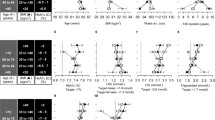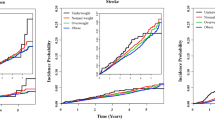Abstract
Aim
To evaluate the risk of CVD and all-cause mortality at different BMI levels in conjunction with weight change prior to diagnosis of T2DM in a multi-ethnic population.
Methods
Longitudinal study of 51,455 patients with T2DM and without a history of comorbid diseases at diagnosis. Weight changes prior to diagnosis of T2DM were evaluated, and the risk of CVD and all-cause mortality at different BMI levels among three ethnic groups estimated using treatment effects model.
Results
White Europeans (WE), African-Caribbeans (AC), and South Asians (SA) were mean 52, 49, and 47 years with a mean BMI of 33.0, 32.0, and 30.0 kg/m2 at diagnosis, respectively. Among WE, normal weight patients developed CVD significantly earlier by 0.5 years (95% CI 0.1, 0.9 years; p = 0.018) compared to obese patients. Furthermore, those with normal body weight at diagnosis were significantly more likely to die earlier by 0.6 years (95% CI 0.03, 1.2 years; p = 0.037) among WE and by 2.5 years (95% CI 0.3, 4.6 years; p = 0.023) among SA compared to their respective obese patients. However, BMI at diagnosis was not associated with increased risk of CVD and death among AC.
Conclusions
This study suggests a paradoxical association of BMI with cardiovascular and mortality risks in different ethnic groups, which may partially be driven by different cardiovascular and glycaemic risk profiles at diagnosis.



Similar content being viewed by others
References
Carnethon MR, De Chavez PJD, Biggs ML, Lewis CE, Pankow JS, Bertoni AG, Golden SH, Liu K, Mukamal KJ, Campbell-Jenkins B, Dyer AR (2012) Association of weight status with mortality in adults with incident diabetes. JAMA 308(6):581–590. https://doi.org/10.1001/jama.2012.9282
Logue J, Walker JJ, Leese G, Lindsay R, Mcknight J, Morris A, Philip S, Wild S, Sattar N, on behalf of the Scottish Diabetes Research Network Epidemiology Group (2013) Association between BMI measured within a year after diagnosis of type 2 diabetes and mortality. Diabetes Care 36(4):887–893. https://doi.org/10.2337/dc12-0944
Mulnier HE, Seaman HE, Raleigh VS, Soedamah-Muthu SS, Colhoun HM, Lawrenson RA (2006) Mortality in people with type 2 diabetes in the UK. Diabet Med 23(5):516–521. https://doi.org/10.1111/j.1464-5491.2006.01838.x
Thomas G, Khunti K, Curcin V, Molokhia M, Millett C, Majeed A, Paul S (2014) Obesity paradox in people newly diagnosed with type 2 diabetes with and without prior cardiovascular disease. Diabetes Obes Metab 16(4):317–325. https://doi.org/10.1111/dom.12217
Zhao W, Katzmarzyk PT, Horswell R, Wang Y, Li W, Johnson J, Heymsfield SB, Cefalu WT, Ryan DH, Hu G (2014) Body mass index and the risk of all-cause mortality among patients with type 2 diabetes. Circulation 130(24):2143–2151. https://doi.org/10.1161/circulationaha.114.009098
Banack HR, Kaufman JS (Cambridge (2013) The “Obesity Paradox” explained. Epidemiology (Cambridge, Mass) 24(3):461–462. https://doi.org/10.1097/EDE.0b013e31828c776c
Banack HR, Kaufman JS (2015) Does selection bias explain the obesity paradox among individuals with cardiovascular disease? Ann Epidemiol 25(5):342–349. https://doi.org/10.1016/j.annepidem.2015.02.008
Hainer V, Aldhoon-Hainerová I (2013) Obesity paradox does exist. Diabetes Care 36(Supplement 2):S276–S281. https://doi.org/10.2337/dcS13-2023
Owusu Adjah ES, Samanta M, Shaw JE, Majeed A, Khunti K, Paul SK (2018) Weight loss and mortality risk in patients with different adiposity at diagnosis of type 2 diabetes: a longitudinal cohort study. Nutr Diabetes 8(1):37. https://doi.org/10.1038/s41387-018-0042-0
Hsu WC, Araneta MRG, Kanaya AM, Chiang JL, Fujimoto W (2015) BMI cut points to identify at-risk asian americans for type 2 diabetes screening. Diabetes Care 38(1):150–158. https://doi.org/10.2337/dc14-2391
Misra A, Vikram NK, Gupta R, Pandey RM, Wasir JS, Gupta VP (2006) Waist circumference cutoff points and action levels for Asian Indians for identification of abdominal obesity. Int J Obes (2005) 30(1):106–111. https://doi.org/10.1038/sj.ijo.0803111
Shai I, Jiang R, Manson JE, Stampfer MJ, Willett WC, Colditz GA, Hu FB (2006) Ethnicity, obesity, and risk of type 2 diabetes in women: a 20-year follow-up study. Diabetes Care 29(7):1585–1590. https://doi.org/10.2337/dc06-0057
Tillin T, Sattar N, Godsland IF, Hughes AD, Chaturvedi N, Forouhi NG (2015) Ethnicity-specific obesity cut-points in the development of type 2 diabetes—a prospective study including three ethnic groups in the United Kingdom. Diabet Med 32(2):226–234. https://doi.org/10.1111/dme.12576
Shah AD, Langenberg C, Rapsomaniki E, Denaxas S, Pujades-Rodriguez M, Gale CP, Deanfield J, Smeeth L, Timmis A, Hemingway H (2015) Type 2 diabetes and incidence of cardiovascular diseases: a cohort study in 1·9 million people. Lancet Diabetes Endocrinol 3(2):105–113. https://doi.org/10.1016/S2213-8587(14)70219-0
U.K. Prospective Diabetes Study Group (1998) Ethnicity and cardiovascular disease: the incidence of myocardial infarction in white, South Asian, and Afro-Caribbean patients with type 2 diabetes (U.K. Prospective Diabetes Study 32). Diabetes Care 21(8):1271–1277. https://doi.org/10.2337/diacare.21.8.1271
Lanting LC, Joung IMA, Mackenbach JP, Lamberts SWJ, Bootsma AH (2005) Ethnic differences in mortality, end-stage complications, and quality of care among diabetic patients: a review. Diabetes Care 28(9):2280–2288. https://doi.org/10.2337/diacare.28.9.2280
Bellary S, O’Hare JP, Raymond NT, Mughal S, Hanif WM, Jones A, Kumar S, Barnett AH (2010) Premature cardiovascular events and mortality in South Asians with type 2 diabetes in the United Kingdom Asian Diabetes Study—effect of ethnicity on risk. Curr Med Res Opin 26(8):1873–1879. https://doi.org/10.1185/03007995.2010.490468
George J, Mathur R, Shah AD, Pujades-Rodriguez M, Denaxas S, Smeeth L, Timmis A, Hemingway H (2017) Ethnicity and the first diagnosis of a wide range of cardiovascular diseases: associations in a linked electronic health record cohort of 1 million patients. PLoS One 12(6):e0178945. https://doi.org/10.1371/journal.pone.0178945
Ramezankhani A, Azizi F, Hadaegh F, Momenan AA (2018) Diabetes and number of years of life lost with and without cardiovascular disease: a multi-state homogeneous semi-Markov model. Acta Diabetologica 55(3):253–262
Lavie CJ, De Schutter A, Patel D, Artham SM, Milani RV (2011) Body composition and coronary heart disease mortality—an obesity or a lean paradox? Mayo Clin Proc 86(9):857–864. https://doi.org/10.4065/mcp.2011.0092
Lavie CJ, Milani RV, Ventura HO (2011) Obesity and the “Obesity Paradox” in cardiovascular diseases. Clin Pharmacol Ther 90(1):23–25. https://doi.org/10.1038/clpt.2011.87
Kokkinos P, Myers J, Faselis C, Doumas M, Kheirbek R, Nylen E (2012) BMI–mortality paradox and fitness in African American and Caucasian men with type 2 diabetes. Diabetes Care 35(5):1021–1027. https://doi.org/10.2337/dc11-2407
Paul SK, Owusu Adjah ES, Samanta M, Patel K, Bellary S, Hanif W, Khunti K (2017) Comparison of body mass index at diagnosis of diabetes in a multi-ethnic population: a case–control study with matched non-diabetic controls. Diabetes Obes Metab 19(7):1014–1023. https://doi.org/10.1111/dom.12915
Read J (1991) The read clinical classification (read codes). Br Homoeopath J 80(1):14–20. https://doi.org/10.1016/S0007-0785(05)80418-1
Owusu Adjah ES, Montvida O, Agbeve J, Paul SK (2017) Data mining approach to identify disease cohorts from primary care electronic medical records: a case of diabetes mellitus. Open Bioinform J 10:16–27. https://doi.org/10.2174/1875036201710010016
WHO Expert Consultation (2004) Appropriate body-mass index for Asian populations and its implications for policy and intervention strategies. Lancet 363(9403):157
Ho AK, Bartels CM, Thorpe CT, Pandhi N, Smith MA, Johnson HM (2016) achieving weight loss and hypertension control among obese adults: a US Multidisciplinary Group Practice Observational Study. Am J Hypertens 29(8):984–991. https://doi.org/10.1093/ajh/hpw020
Rubin DB (1974) Estimating causal effects of treatments in randomized and nonrandomized studies. J Educ Psychol 66(5):688. https://doi.org/10.1037/h0037350
Austin PC, Stuart EA (2015) The performance of inverse probability of treatment weighting and full matching on the propensity score in the presence of model misspecification when estimating the effect of treatment on survival outcomes. Stat Methods Med Res 26(4):1654–1670. https://doi.org/10.1177/0962280215584401
Cattaneo MD (2010) Efficient semiparametric estimation of multi-valued treatment effects under ignorability. J Econom 155(2):138–154. https://doi.org/10.1016/j.jeconom.2009.09.023
Lee M-j (2012) Treatment effects in sample selection models and their nonparametric estimation. J Econom 167(2):317–329. https://doi.org/10.1016/j.jeconom.2011.09.018
Lavie CJ, McAuley PA, Church TS, Milani RV, Blair SN (2014) Obesity and cardiovascular diseases. J Am Coll Cardiol 63(14):1345–1354. https://doi.org/10.1016/j.jacc.2014.01.022
Zheng Y, Song M, Manson JE, Giovannucci EL, Hu FB (2017) Group-based trajectory of body shape from ages 5 to 55 years and cardiometabolic disease risk in 2 US cohorts. Am J Epidemiol 186(11):1246–1255. https://doi.org/10.1093/aje/kwx188
Canoy D, Wareham N, Luben R, Welch A, Bingham S, Day N, Khaw KT (2005) Cigarette smoking and fat distribution in 21,828 British men and women: a population-based study. Obes Res 13(8):1466–1475. https://doi.org/10.1038/oby.2005.177
Wright AK, Kontopantelis E, Emsley R, Buchan I, Sattar N, Rutter MK, Ashcroft DM (2016) Life expectancy and cause-specific mortality in type 2 diabetes: a population-based cohort study quantifying relationships in ethnic subgroups. Diabetes Care. https://doi.org/10.2337/dc16-1616
Penno G, Solini A, Bonora E, Orsi E, Fondelli C, Zerbini G, Trevisan R, Vedovato M, Cavalot F, Laviola L (2018) Defining the contribution of chronic kidney disease to all-cause mortality in patients with type 2 diabetes: the Renal Insufficiency And Cardiovascular Events (RIACE) Italian Multicenter Study. Acta Diabetol 55(6):603–612. https://doi.org/10.1007/s00592-018-1133-z
Owusu Adjah ES, Bellary S, Hanif W, Patel K, Khunti K, Paul SK (2018) Prevalence and incidence of complications at diagnosis of T2DM and during follow-up by BMI and ethnicity: a matched case–control analysis. Cardiovasc Diabetol 17(1):70. https://doi.org/10.1186/s12933-018-0712-1
Acknowledgements
Melbourne EpiCentre gratefully acknowledges the support from the Australian Government’s National Collaborative Research Infrastructure Strategy (NCRIS) initiative through Therapeutic Innovation Australia.
Funding
National Health and Medical Research Council of Australia (GNT1063477).
Author information
Authors and Affiliations
Contributions
SKP and ESOA conceived the idea and contributed to the study design. ESOA conducted the data extraction, data manipulation, and statistical analyses and developed the first draft of the manuscript. SKP contributed to the statistical analyses and had full access to all the data in the study and is the guarantor, taking responsibility for the integrity of the data and the accuracy of the data analysis. ESOA, KKR, and SKP were involved in writing the paper and had final approval of the submitted and published versions.
Corresponding author
Ethics declarations
Conflict of interest
SKP has acted as a consultant and/or speaker for Novartis, GI Dynamics, Roche, AstraZeneca, Guangzhou Zhongyi Pharmaceutical and Amylin Pharmaceuticals LLC. He has received grants in support of investigator and investigator-initiated clinical studies from Merck, Novo Nordisk, AstraZeneca, Hospira, Amylin Pharmaceuticals, Sanofi Aventis and Pfizer. KKR has acted as a speaker or consultant for Abbvie, Amgen, Pfizer, Astra Zeneca, Sanofi Resverlogix, Regeneron, Esperion, ACKCEA, Medicines Company, BI, Novo Nordisk. ESOA has no conflicts of interest to declare.
Statement of human and animal rights
This article does not contain any studies with human or animal subjects performed by the any of the authors.
Additional information
Managed by Massimo Federici.
Electronic supplementary material
Below is the link to the electronic supplementary material.
Rights and permissions
About this article
Cite this article
Owusu Adjah, E.S., Ray, K.K. & Paul, S.K. Ethnicity-specific association of BMI levels at diagnosis of type 2 diabetes with cardiovascular disease and all-cause mortality risk. Acta Diabetol 56, 87–96 (2019). https://doi.org/10.1007/s00592-018-1219-7
Received:
Accepted:
Published:
Issue Date:
DOI: https://doi.org/10.1007/s00592-018-1219-7




